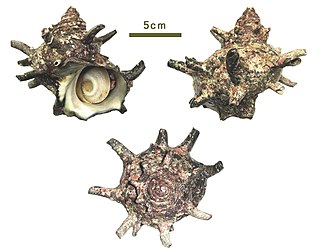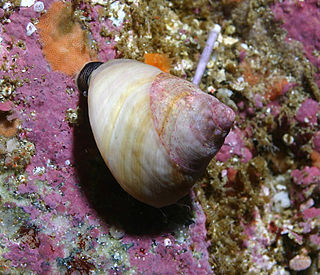Strepsodiscus is an extinct genus of very primitive fossil snail-like molluscs from the early part of the Late Cambrian of North America. The coiled, slightly asymmetrical shells are about 3 cm in height. It is not known whether these are shells of gastropods or monoplacophorans, which are more primitive mollusks.

The Bellerophontidae are an extinct family of specialized globose bellerophontids, Paleozoic and early Triassic mollusks of the class Gastropoda.

Turbinidae, the turban snails, are a family of small to large marine gastropod molluscs in the superfamily Trochoidea.
Stomatellinae is a subfamily of small sea snails with a brilliantly nacreous interior of the shell, marine gastropod mollusks in the family Trochidae, the top snails.

Liotiidae is a family of small sea snails, marine gastropod mollusks in the clade Vetigastropoda.

Phasianellidae common name the "pheasant shells" or "pheasant snails" is a family of small sea snails with calcareous opercula, marine gastropod mollusks in the clade Vetigastropoda.

Vetigastropoda is a major taxonomic group of sea snails, marine gastropod mollusks that form a very ancient lineage. Taxonomically the Vetigastropoda are sometimes treated as an order, although they are a clade in Bouchet and Rocroi, 2005.

Bellerophontoidea,, common name "bellerophonts", is a superfamily of extinct planospirally-coiled globose molluscs. This superfamily is generally included within the Gastropoda, but may instead be a group of monoplacophorans. The taxon first appeared late in the Cambrian and continued until late in the Triassic.

Turbinoidea was a superfamily of small to large sea snails, marine gastropod mollusks in the clade Vetigastropoda. But it has become an available name, because it is no longer used in the current taxonomy of gastropods sensu Williams et al. (2008).
Bucanellidae is an extinct family of Paleozoic molluscs of uncertain position, belonging either to Gastropoda (snails) or Monoplacophora. The family lived from the upper Cambrian to middle Permian and the shells are characterized by a relatively small median sinus in the upper margin of the aperture, and collabral (transverse) or spiral (longitudinal) threads covering the shell. The shells are planispirally coiled rather than trochospirally with a spire as is the case with most shelled gastropods.
Bucaniidae is an extinct family of paleozoic molluscs of uncertain position possibly being either Gastropods or Monoplacophorans in the superfamily Bellerophontoidea. The family lived from the Lower Ordovician to the Devonian and have shells in which the apertural margins tend to flare. Most genera have a slit and selenizone, others some modification of this feature.

Macluritidae is an extinct family of relatively large, Lower Ordovician to Devonian, macluritacean gastropods(?), hypserstrophically coiled, that is dextral while appearing sinsitral, of which the genus Maclurites is arch-typical. The base of their shells is flat or gently protruding while the upper side is generally concave.
Paraturbinidae is an extinct family of snails from the Mesozoic period, gastropod mollusks.
The †Raphistomatidae is a taxonomic family of fossil sea snails, Paleozoic marine gastropod mollusks. This family was established by Koken in 1896. This family is found in the fossil record from the Upper Cambrian to the Middle Permian.

Angarioidea is a superfamily of small to medium sized sea snails, marine gastropod mollusks in the clade Vetigastropoda.
This overview lists proposed changes in the taxonomy of gastropods at the family level and above since 2005, when the taxonomy of the Gastropoda by Bouchet & Rocroi (2005) was published. In other words, these are recent updates in the way various groups of snails and slugs are classified.
The Trochina is a taxon that is used by paleontologists. It is a suborder of primitive sea snails, marine gastropod mollusks.

Margaritidae is a family of small sea snails, marine gastropod mollusks in the superfamily Trochoidea.
Trochida is an order of small to very large vetigastropod, Recent and extinct sea snails with gills and an operculum.














